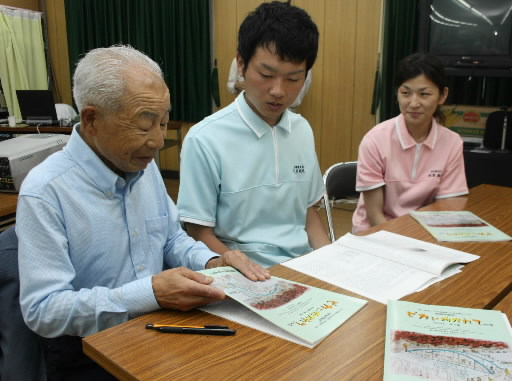Sharing the A-bomb Experience, Part 3
Aug. 1, 2009
Speaking out to avoid regret
by Kyosuke Mizukawa, Staff Writer
He places his hands together in pray, every morning and evening, before the photos of his family, asking them for forgiveness. “I was selfish,” he says. The scene inside the streetcar they were riding together is brought back to mind with enduring remorse.
Sixty-four years ago, Masao Matsumoto, 75, now a resident of Asakita Ward in Hiroshima, lived with his parents in Funairi in downtown Hiroshima. Mr. Matsumoto, though, had alone been evacuated to his grandfather’s house in the northern suburb of Kabe and began attending Kabe Elementary School. But it was hard for the 11-year-old boy to live apart from his family. On August 4, he returned to his home in Funairi and begged: “I want to be with you.” His mother understood his feelings.
In the early morning of August 6, his mother boarded a streetcar from a streetcar stop near their home with her three children, including Mr. Matsumoto, to visit his grandfather to explain the situation. His younger sister wore a pink holiday dress. She was amusing his younger brother, who was being carried on his mother’s back.
At 8:15 a.m., the crowded streetcar was abruptly cloaked in darkness at a point about 700 meters west of the hypocenter. Buildings collapsed in the surrounding area and a raging fire closed in on them.
Fleeing to the north along the Otagawa River, they managed to arrive at their relatives’ house. Mr. Matsumoto’s younger sister suffered burns to her face and died nine days after the bombing. His younger brother, his head bleeding, died two days later. And his mother, who continued clutching their lifeless bodies, then passed away at the age of 34. “I’ve lost our precious children,” she said. “Please tell your father I’m so sorry.”
“I’m going to die with you!” Mr. Matsumoto cried out. He had suffered severe burns to his legs and overheard someone say, “This boy won’t live long, either.” Still, he managed to survive after four months of medical care.
After graduating from junior high school, he served an apprenticeship at a factory that made molds. At 25, he left the factory to continue his work independently. He remained silent in regard to his A-bomb experience, though, as he did not want to recall the trauma of the event or suffer discrimination in work or marriage.
But his feelings of remorse toward his family did not disappear. In 1975, when he was 40, he responded to an appeal put out by the Hiroshima broadcasting station NHK for drawings of the atomic bombing. Mr. Matsumoto steeled himself, took up a brush, and painted a picture of his mother and sister running to escape the sea of fire.
More than 30 years passed before an unexpected occurrence led him to finally speak about his experience.
In 2007, his doctor happened to see Mr. Matsumoto’s picture on display at Hiroshima Peace Memorial Museum and asked him to speak about his A-bomb experience. Mr. Matsumoto was about to turn down the request straight away, but then the image of his mother, sister, and brother rose in his mind. “The atomic bombing destroyed so many families,” Mr. Matsumoto said. “It must never be repeated. I don’t want to later regret being silent about my A-bomb experience.” For the first time, in front of about 30 people, he gave his account of the atomic bombing.
Concerning his father, who had left to fight the war in China, only locks of his hair came back to Japan, two years after the war had ended. On the wall of Mr. Matsumoto’s home hangs a photo of his father beside the photo of his mother, sister, and brother riding a streetcar.
“Why was I the only one who survived? Was it to convey the experience of the bombing?” wonders Mr. Matsumoto. At the end of June, he presented a book to the photos of his family. The book, a collection of the A-bomb experiences of eight atomic bomb survivors, includes Mr. Matsumoto’s account. It was compiled by young nurses and occupational therapists who listened to the survivors’ stories. On the front cover of the book is the picture of the atomic bombing made by Mr. Matsumoto.
(Originally published on July 25, 2009)








